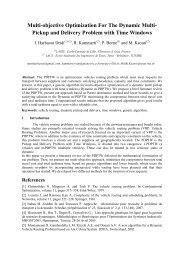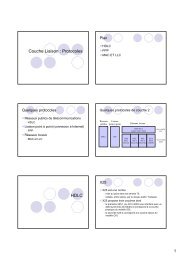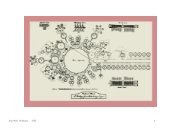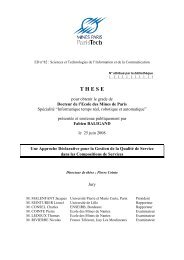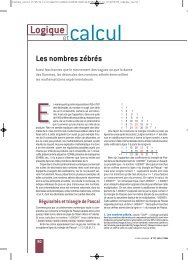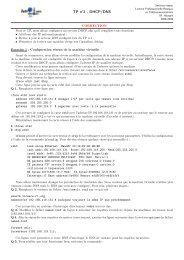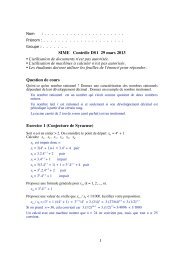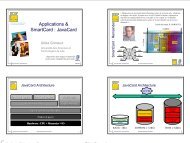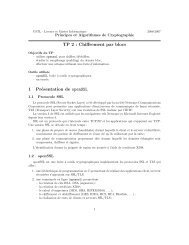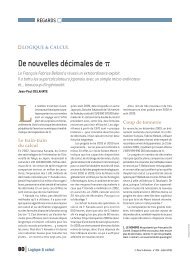An Introduction to Test-Driven Code Generation - LIFL
An Introduction to Test-Driven Code Generation - LIFL
An Introduction to Test-Driven Code Generation - LIFL
Create successful ePaper yourself
Turn your PDF publications into a flip-book with our unique Google optimized e-Paper software.
EuroPython 2006 Refereed Paper Track<br />
in the same context. In the context of web applications for example, the implementation<br />
of most functions may lay in four categories: input form processing<br />
(like inserting a student in the system), output form processing (like obtaining<br />
the list of all the students), input / output form processing (like updating the<br />
informations related <strong>to</strong> a student) and search processing (like obtaining the list<br />
of non affected projects). Identifying these similarities and understanding their<br />
differences permits the development of code genera<strong>to</strong>rs that (a) reduces the<br />
amount of repetitive work (thus the underlying potential errors), (b) improves<br />
the software quality (enforcing coding rules, not leaving unfinished copy / paste,<br />
and so on), and (c) reduces the development time. In all that, code generation<br />
is a way <strong>to</strong> achieve Au<strong>to</strong>mation [13], allowing you <strong>to</strong> focus on the true value of<br />
your applications: the specificities of the functions expected by your users (their<br />
business rules) instead of some details of their implementation (being sure that<br />
all the screens respect the same rules).<br />
Like for any piece of software, developing code genera<strong>to</strong>rs is not that easy.<br />
The main goal of this paper is <strong>to</strong> present a solution <strong>to</strong> help you support code<br />
generation. We have a look at how <strong>to</strong> develop a code genera<strong>to</strong>r using TDD<br />
and how <strong>to</strong> benefit from code generation while test-driven developing. As an<br />
example, we build parts of a 3-tiers web application. The goal is not <strong>to</strong> compete<br />
with frameworks such as Django [7] or TurboGear [18]. The use of a web<br />
application as an illustration example has been motivated by the fact that many<br />
readers may know what a web application is.<br />
This introduction <strong>to</strong> <strong>Test</strong>-<strong>Driven</strong> <strong>Code</strong> <strong>Generation</strong> (TDCG) relies on the<br />
use of Python standard unittest module [19], CheeryPy [4] web application<br />
framework, and Cheetah [3] template engine. Python unittest is not the only<br />
choice for TDD, however it fits well as a standard module and as a support for<br />
writing unit tests. Other testing frameworks such as doctest [8] and py.test<br />
[16] can also be considered for this purpose (but have not been experimented<br />
yet in the scope of TDCG). CherryPy has been chosen for two reasons: Writing<br />
CheeryPy classes is very similar <strong>to</strong> writing Python classes, and CheeryPy classes<br />
are well suited for TDD as they are easily test-able without setting up “HTTP<br />
testing”. Finally, Cheetah is both well suited for code generation and quite easy<br />
<strong>to</strong> start working with.<br />
This paper first presents an overview of the proposed approach for developing<br />
code genera<strong>to</strong>rs using TDD as well as a short presentation of the application<br />
we are going <strong>to</strong> build (section 2). As we are about <strong>to</strong> see in the coming section,<br />
writing a code genera<strong>to</strong>r begins with writing examples of the code <strong>to</strong> be generated.<br />
Thus, we are going <strong>to</strong> test-driven develop two use cases (or user s<strong>to</strong>ries)<br />
of our application (sections 3 and 4). On the basis of these code samples, we are<br />
going <strong>to</strong> build a first version of our code genera<strong>to</strong>r (section 5). Finally, as we<br />
are producing only part of the application code, we still have <strong>to</strong> fill the holes.<br />
So <strong>to</strong> be more confident on the code we hand write we will follow the TDD<br />
approach. The last part of the article tackles the generation of the test cases<br />
(section 6): Here again we do not generate the complete test cases, but only<br />
their skele<strong>to</strong>ns 1 .<br />
1 Writing complete test case au<strong>to</strong>matically is possible and already performed in some <strong>to</strong>ols,<br />
however it is beyond the scope of this paper.<br />
2



